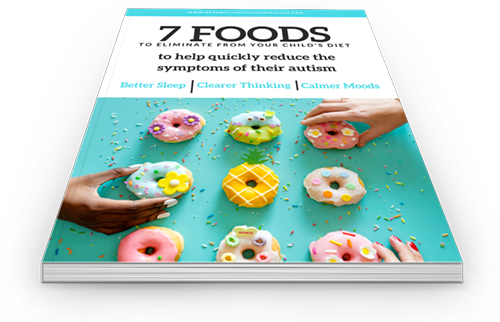Autism is called a spectrum disorder because no two people with autism have the same exact symptoms. It’s a long spectrum with one end being those who are higher functioning and the other end being those who are very low functioning. The meaning behind the word “functioning” depends on their ability to navigate through life. Some symptoms simply make life more challenging.
For example, a very high functioning individual was once referred to as having “Aspergers Syndrome”. This term was first described in 1944 by Austrian physician Hans Asperger. In 2013, The Diagnostic and Statistical Manual of Mental Disorders (DSM–5), removed the term Aspergers, and placed this diagnosis under an umbrella of autism spectrum disorders, lesser defining it.
In broader terms, individuals who are higher functioning may be able to go to school, talk to others, tolerate their sensory processing issues more easily than those who are lower functioning, but life is still much more complicated for them than someone who is neurotypical. Higher functioning, “Asperger’s” people are usually unable to understand common social cues, and struggle with communication.
People who have higher functioning autism may not even be known to others as someone on the spectrum. Most people are not educated in recognizing these signs. Higher functioning individuals may have more difficulties than lower functioning autistics because they are not easily known to have their challenges. They often get less help than lower functioning individuals with autism because their needs can often be missed by teachers and peers. They can even go undiagnosed for years, or an entire lifetime.
Isolation is common for those on the autism spectrum because socialization becomes so difficult at times that they tend to either choose to avoid people or they are not befriended by others due to a social awkwardness. They are just thought to be different but not known to have actual disabilities that prevent them from comfortably connecting with others and doing the day to day tasks that neurotypical people take for granted. Autism can make it difficult to understand others’ actions or intentions and how to reciprocate in a common social fashion. They may internalize their anxiety or lack of ability to focus, so to others they just seem lazy or defiant or unsocial. They are commonly seen as loners, even though they often are desperate to make friends and social interaction Loneliness is common.
People who are low functioning with autism have many more challenges. Some common symptoms, but not all, may be very little or no speech, inability to focus, anxiety, aggression, poor sleep, poor immunity, inability to dress or care for themselves, and may remain in diapers into adulthood.
How do health issues contribute to the symptoms of autism?
A study in The Journal of Neuroscience, Gut Microbes and the Brain: Paradigm Shift in Neuroscience, found that, “alterations in the gut microbiome may play a pathophysiological role in human brain diseases, including autism spectrum disorder, anxiety, depression, and chronic pain”. The gut directly affects the ability of the brain to function. Bacteria in the gut communicate with the brain, and the neurotransmitters, brain messengers, are made in the gut. The gut also makes up 80% of the immune system. Conclusion: the gut controls the brain and the immune system.
In my fourteen years of autism research, recovering my son from his symptoms of autism after being told it could not be done, and working with hundreds of parents of children with autism, I have found that all people with autism have many biological, health related issues in common. These issues often include poor immunity, a predisposition to viral and bacterial illnesses and infections, toxic overload, a weak and leaky gut with digestive difficulties, (ie, a bad gut microbiome), malnutrition due to poor absorption of nutrients, poor detoxification pathways, a higher sensitivity to environmental toxins, infections such as Lyme, mold biotoxins, autoimmune issues, mycotoxins, parasitic infections due to a weak gut and poor functioning digestion, and more.
As these biological issues are cleared “recovered from” the brain can function at optimum and many symptoms disappear. For some, like my own son, the symptoms are all no longer present and the person is able to live a productive, healthy, happy and fulfilling life. This is a life that is very much different than the one they had before their health was restored.
Autism is a biological issue. It is not a mental illness. This is why autism can be recovered from. The definition of recovery is to regain health. If we work with the causes of the health issues effecting their body then we can restore health to the brain. Inflammation and toxicity are commonplace for people with autism, and they disable the brain from proper functioning.
There are four stages to autism recovery as I’ve learned to know them:
Stage 1: Healing the gut and balancing the microbiome
Stage 2: Natural heavy metal detoxification
Stage 3: Clearing the co-infections of autism (mold, Lyme, PANS/strep, parasites)
Stage 4: Brain support and repair (once the toxins and inflammation are out of the way then you know the real personality of an individual and their remaining needs for support).
Beginning with the gut healing is paramount because it lays the foundation for stabilizing, assisting detoxification pathways, reducing inflammation, and balancing the gut microbiome. All of this is done to strengthen the innate immune system and help restore the brain’s balance. Speech, focus, sleep, irritability and aggression, anxiety, sensory processing issues, muscle and motor function, vision, hearing, respiratory issues, hormonal balance, social connection, and so much more can be restored by working with these causes, not just the symptoms.
What You Can Do
Many parents ask for my help. I like to begin with the first step in healing the gut, diet. Yes, autism recovery is much more than diet alone and it’s why many parents fall short of optimum results thinking that is all there is. Here we begin with diet then move forward from there.
Transitioning to the right diet foods can be very difficult because the bad bacteria in the gut that have overgrown and killed off the good bacteria (the microbiome imbalance we talked about). The overgrowth of candida can cause toxicity and inflammation in the gut, therefore distressing the brain. Removing the foods that feed the bad bacteria is the first step. There are a few specific foods that must be removed for a multitude of reasons. Get your free guide to the top 7 foods to remove from the diet to help reduce the symptoms of autism. It explains many of the details behind why these foods need to be removed too.
Your child is addicted to these foods because they contain sugars the candida feed off of to thrive, and many contain opiates, just like the drug, so their cravings make them want them even more. This transition can be difficult because the “picky eating” issue makes it hard to transition away from the bad foods and into more of the good ones that help heal the gut and do not feed the bad bacteria. The process must be done very slowly.
Join the Autism Recovery Action Plan for Parents of Children with Autism
Discover natural strategies to improve your child’s communication, social skills, behavior, and overall well being during this FREE 3 day action plan.
APRIL 2-4, 2025
9 AM PST | 12 PM EST
1-HOUR DAILY FOLLOWED BY LIVE Q&A
Navigating the realm of autism can be challenging. I know I’ve lived it, too. But you don’t have to do this alone. For the sum of zero dollars, you can join our community of dedicated parents who are actively shaping brighter futures for their children through this enriching 3-day experience. It is my gift to help ease your journey.
Our 3-Day Autism Recovery Action Plan serves as a guiding light on your journey, offering affordable, proven strategies and the support of a caring community.
This is for informational purposes only and is not meant to diagnose or treat. Every child’s level of recovery is different. No two people are the same. It is never implied that all children will have the same outcome. Results are all based on individual biology and the work that is done. This process takes time and various steps, effort and resources need to be weighed. Our programs are intended to help you become more knowledgeable and guide you to help bring your child a better quality of life, whatever that may be. We want to help by giving great content, direction and strategies that move you forward. Nothing on this page or any of our websites is a promise or guarantee of results or future outcomes. The results on this page and any of our websites are not typical or promised. In fact, there will be people who purchase this and other programs and never put the work into implementing the strategies taught and therefore will achieve little to no results. Our more detailed earnings disclaimer, privacy policy, and terms and conditions for this program and website can be accessed via the links below. We hold ourselves (and you) to a high standard of integrity. We are cheering you on every step of the way.












